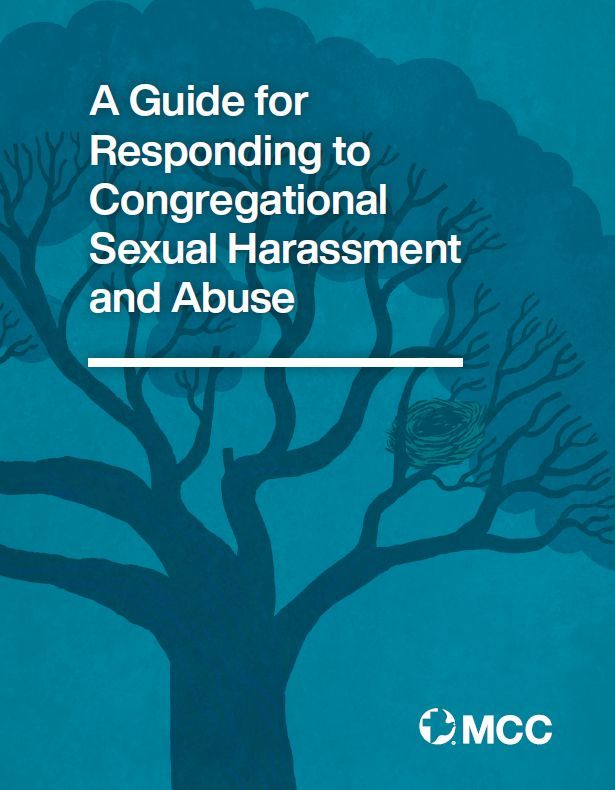

Jaymie Friesen (left) and David Driedger (right) are the authors of MCC's Guide for Responding to Congregational Abuse and Harassment.
 A new resource is available for churches struggling with congregational abuse.
A new resource is available for churches struggling with congregational abuse.
“A Guide for Responding to Congregational Sexual Harassment and Abuse” is written by Jaymie Friesen, Mennonite Central Committee Manitoba’s Abuse Response and Prevention Coordinator, and David Driedger, theologian and pastor at First Mennonite Church in Winnipeg.
Centered on “survivor-centred care,” the guide is for situations that do not involve children or church-leaders, taking into account needs and options for addressing situations of harm where no formal investigation takes place.
The guide was funded and developed by Mennonite Central Committee Canada, Mennonite Church Eastern Canada and Mennonite Church Manitoba.
Friesen and Driedger will be part of an online webinar on March 16 to discuss the resource. To register, visit CommonWord.
The guide authors answered our questions on survivor-centred support and the challenges of restorative work in congregations.
This interview has been edited for length and clarity.
You write in the introduction that, when researching for this document, there were few existing policies that “offered practical guidance for how to respond in healing-centred ways.” Can you elaborate on that? Why is survivor-centered support so important?
David: The truth is that I couldn't find *any* developed policy that addressed sexual harassment or abuse between members/participants in a church. Most dealt with clergy abuse or with minors or were designed for workplaces. As we surveyed relevant policies and spoke with survivor advocacy groups, we learned that most existing policies were written for those administering the policy as opposed to those who have experienced harassment or abuse themselves. We wrote it with survivors in mind.
Jaymie: When our responses are guided by principles of survivor-centered care, we start from a place of deep listening, slowing down, addressing safety and ensuring those harmed have a voice in how processes unfold. Around 90 per cent of the situations congregants encounter don’t require an investigation or adjudicative process, and in fact, too often those processes deter people from coming forward. The guide recognizes the limitations and/or benefits of different options, and gives those who have been harmed agency in how a process unfolds and maintains the rights and dignity of the harm-doer. In my opinion, survivor-centered support is synonymous with restorative justice approaches, which first and foremost ask the questions: who has been harmed, what do they need and whose responsibility is it to meet those needs?
Around 90 per cent of the situations congregants encounter don’t require an investigation or adjudicative process, and in fact, too often those processes deter people from coming forward.
This guide is intended to be used as a “policy template.” How can the template be used?
Jaymie: A lot of the guide, especially the first half, is written using second person (“you”), which was intentional. It speaks to anyone in the community who has experienced or witnessed something concerning or violating. We wanted the language of the guide to be simple, and easy to understand and accessible to all.
We are asking churches/denominations to use the guide in ways that maintain its integrity, but to customize it with information and resources specific to the respective region and roles within the church and community.
The purpose of this guide is to support those who notice or experience abuse/harassment within their own congregation. In your experience, what is the hardest thing for congregants to understand about abuse within their own congregation? What is the biggest barrier towards healing for those involved and why?
David: My experience is that it is really difficult for someone to accept that their behaviour adversely impacted someone beyond their intention. That is, I think most people want to hold to there being a “misunderstanding” rather than accepting that their behaviour constituted harassment or abuse. More broadly, I think churches need to simply accept that otherwise seemingly “good” people are capable of abuse.
Healing is something I have been thinking a lot about recently and I am not sure I know or have witnessed many examples. I think at least part of it is knowing what to hold on to and what to let go of. I don't think those are easy questions in situations of harm.
Jaymie: I appreciate what David said. Our perception might be that we live in a time where people are empowered and emboldened to speak up, and this might be scary for churches – “what if we implement this guide and people start making a stink about seemingly benign interactions.” But more often than not, from where I sit, I witness people doubting and questioning interactions, comments and behavior that were without a doubt misogynistic, inappropriate or violating.
I think churches still have a lot of work to do in terms of education: talking about healthy vs. unhealthy relationships and boundaries, giving people language for their experiences. Lack of education and awareness is a definite barrier to reporting. Another barrier is not knowing what will happen if something is said. Some people are scared nothing will happen or they won’t be believed; others are scared that the harm-doer will be punished or it will create division, additional stress or conflict. That’s why this guide is so important. It recognizes these realities and takes into account that, depending on needs, safety concerns and severity, different responses are appropriate.
I think churches still have a lot of work to do in terms of education.
The antithesis of a survivor- or healing-centered response is when churches respond from a place of institutional protectionism, consulting with lawyers and letting a fear of litigation dictate the process. I think so much pain and re-traumatization could be prevented if we prioritized voice, agency and safety first.
You propose a denominational Safe Church Network with representatives from congregations. Why is it important to offer opportunities for resourcing and networking on this issue?
David: Practically speaking, it is easy for churches to adopt policies and then more or less forget about them (until they are urgently needed!) unless there is an engaged and supportive structure to ensure they are properly led and communicated within churches. In my limited experience, I also find that each situation presents its own unique elements, which makes it hard to simply “apply” a policy. Networking can hopefully allow for a better cumulative understanding of these realities in applying the policy.
Jaymie: Agreed, implementing this guide and resourcing churches to grow a culture of prevention is an ongoing process. We need people in our churches championing this work and those champions need support and resources. There is so much we can learn from one another. We are stronger together.
You write: “True restoration occurs only within a culture where truth-telling, safety, support and accountability are prioritized.” What is your hope for this resource?
David: Dealing with disclosures and realities of sexual abuse and harassment can be overwhelming and isolating for everyone involved. I hope that this resource facilitates important conversations and encourages accountable responses. Early on in the document we write, “Anything you saw or experienced that did not feel right is worth talking about with someone you trust.” We should be open to new information about understanding our experiences but we also should not deny our gut when something feels off. We should not have to deal with that alone. The question is whether we can encourage healthy, supportive and accountable ways of understanding and responding to our experiences. Addressing conflict and promoting healing increasingly strike me as requiring a lifelong commitment to learning and insight. I hope this document is helpful in this regard and can be improved on in the future.
Addressing conflict and promoting healing increasingly strike me as requiring a lifelong commitment to learning and insight.
Jaymie: Beautifully said David. I really hope this guide is far more than a crisis-management tool, that churches use it as part of a wider shift in church culture and practice. It would be great if this guide inspired churches to dedicate time and energy to preaching, teaching and equipping congregants on themes related to healthy vs. unhealthy relationships, healthy masculinity, boundaries, consent, domestic violence, bullying, power and vulnerability. I would love to see churches become places that deeply acknowledge the prevalence of abuse, that approach ministry through a trauma-aware lens and prioritize initiatives and conversations that foster relational healing and justice.